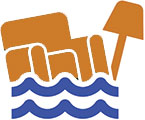Floods are the most common natural hazard in the United States, and recent fires make this storm season of particular risk for landslides and debris flows. Storms, floods and slides can cause property damage, loss of utilities, and loss of life, so plan now and be prepared to act. Review your emergency supply kit, make a plan for the whole family, help your neighbors get ready, and make sure you can stay informed and be alerted to hazards in your area.
If You are Under a Flood Warning, Find Safe Shelter Right Away
-
 Do not walk, swim, or drive through flood waters. Turn Around, Don’t Drown!
Do not walk, swim, or drive through flood waters. Turn Around, Don’t Drown!
- Just 6 inches of moving water can knock you down, and one foot of moving water can sweep your vehicle away.
- Stay off of bridges over fast-moving water.
- Determine how best to protect yourself based on the type of flooding.
- Evacuate if told to do so.
- Move to higher ground or a higher floor.
- Stay where you are.
Preparing before Flood
- Sign up for SoCo Alert
- Know types of flood risk in your area. Visit FEMA’s Flood Map Service Center for information.
- If flash flooding is a risk in your location, then monitor potential signs, such as heavy rain.
- Learn and practice evacuation routes, shelter in place plans, and flash flood response.
- Make sure your Go Bag is ready in case you have to leave immediately, or if water and power services are turned
- Keep in mind each family member’s specific needs, including medication. Don’t forget the needs of pets.
- Obtain extra batteries and charging devices for phones and other critical equipment in case of power outages.
 Purchase or renew a flood insurance policy. It typically takes up to 30 days for a policy to go into effect and can protect the life you’ve built. Homeowner’s policies do not cover flooding. Get flood coverage under the National Flood Insurance Program (NFIP)
Purchase or renew a flood insurance policy. It typically takes up to 30 days for a policy to go into effect and can protect the life you’ve built. Homeowner’s policies do not cover flooding. Get flood coverage under the National Flood Insurance Program (NFIP)- Keep important documents in a waterproof container and create a password-protected digital copies.
- Protect your property. Move valuables to higher levels. Declutter drains and gutters. Install check valves. Consider a sump pump with a battery.
- Check in with neighbors who may need assistance getting ready and evacuating.
During a Flood
- Depending on where you are, as well as the impact and the warning time of flooding, go to the safe location that you previously identified.
- Listen to EAS, NOAA Weather Radio, or local alerting systems for current emergency information and instructions.
- Do not walk, swim, or drive through flood waters. Turn Around. Don’t Drown!
- If your vehicle is trapped in rapidly moving water, then stay inside. If water is rising inside the vehicle, then seek refuge on the roof.
- If trapped in a building, then go to its highest level. Do not climb into a closed attic. You may become trapped by rising floodwater. Go on the roof only if necessary. Once there, signal for help.
